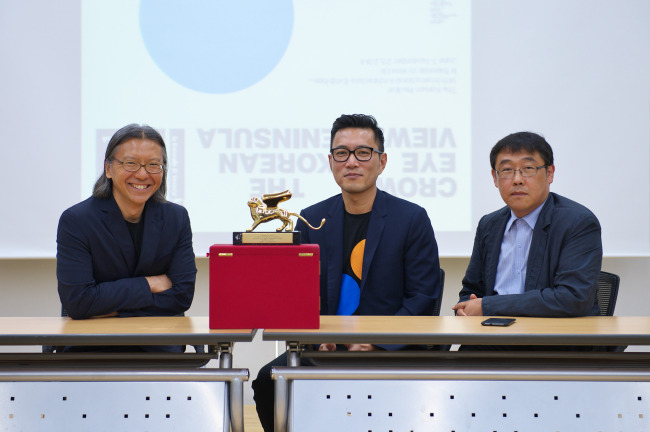Team sheds light on architectural differences between two Koreas
Korea Pavilion gets top award at Venice Architecture Biennale
By Korea HeraldPublished : June 13, 2014 - 20:26
Deviating from past editions, this year’s Venice Architecture Biennale asked all 66 participating countries to respond to a common theme ― to focus not on architecture itself but on architectural “history” in order to examine how different nations adapted to modernity in design over the last century.
The Korean Pavilion has spotlighted differences in the architecture of South and North Korea since national division, for which it was awarded the Golden Lion for Best National Participation on June 7.
It is the first time that Korea won the Golden Lion in the Venice Biennale, either in architecture or art. The event is held every year, alternating between architecture and art exhibitions.
“With this year’s theme ‘Absorbing Modernity: 1914-2014,’ (the director of the 2014 Venice Architecture Biennale) Rem Koolhaas sought to provide a forum to reflect on the remaining issues of the 20th century, during which just about every country in the world experienced a takeover, war or separation,” said commissioner of the Korean Pavilion Cho Min-suk at a press conference in Seoul on Thursday.
The Korean Pavilion has spotlighted differences in the architecture of South and North Korea since national division, for which it was awarded the Golden Lion for Best National Participation on June 7.
It is the first time that Korea won the Golden Lion in the Venice Biennale, either in architecture or art. The event is held every year, alternating between architecture and art exhibitions.
“With this year’s theme ‘Absorbing Modernity: 1914-2014,’ (the director of the 2014 Venice Architecture Biennale) Rem Koolhaas sought to provide a forum to reflect on the remaining issues of the 20th century, during which just about every country in the world experienced a takeover, war or separation,” said commissioner of the Korean Pavilion Cho Min-suk at a press conference in Seoul on Thursday.

“I think that we were able to fulfill that task better than any other country ... Korea, a divided nation, is the last remaining puzzle after the past 100 years of world history. That is precisely what captured the world’s attention,” he said.
Entitled “Crow’s Eye View: The Korean Peninsula,” the Korea Pavilion exhibition compares the architectural modernization of the two Koreas, with a focus on the changes before and after the division. The exhibition reveals how the architecture of the communist North and capitalist South embody their different ideological paths after the 1950-53 Korean War. It seeks to move away from the cliches of the divided states and explore similarities between the two states as they both pursued the common goal of reconstruction and modernization.
The display is the result of more than 15 months of planning and preparation by Cho, who runs his own architecture firm, Mass Studies, in Korea, and his curatorial team. After trying in vain to present a joint exhibition with North Korean architects, they collected photographs, paintings and sketches of North Korean architecture, mostly from foreign sources.
The biennale’s international jury recognized their “extraordinary achievement of presenting a new and rich body of knowledge of architecture and urbanism in a highly charged political situation.”
“It is research in action that expands the spatial and architectural reality into the geopolitical identity,” the jury said.
“I actually expected that we would win an award. In several press conferences, Rem Koolhaas would always recommend the Korea Pavilion as a key exhibit, and the international jury expressed great interest as well,” Cho said.
Ahn Chang-mo, cocurator of the Korea Pavilion and professor at Kyonggi University, noted the significance of the team’s achievement in Korean architecture.
“I believe our achievement enabled us to give Korean history and architecture much-needed recognition on an international stage,” Ahn said. “Instead of placing emphasis on mere participation in the Venice Biennale, we can now have more confidence in our own architecture and works.”
Bae Hyung-min, cocurator and professor at the University of Seoul, said more needs to be done to support Korean architecture.
“Right now, the state of Korean architecture is quite weak. For instance, though architecture is considered a form of culture, Korea has yet to build its own architecture museum. I hope that architecture will gain more recognition culturally and socially,” said Bae.
“Crow’s Eye View: The Korean Peninsula” will be displayed at the Venice Architecture Biennale until Nov. 23. The exhibit will be displayed in Seoul at the Arco Art Center in early 2015.
By Sohn Ji-young (jiyoung.sohn@heraldcorp.com)
-
Articles by Korea Herald



![[Herald Interview] 'Amid aging population, Korea to invite more young professionals from overseas'](http://res.heraldm.com/phpwas/restmb_idxmake.php?idx=644&simg=/content/image/2024/04/24/20240424050844_0.jpg&u=20240424200058)

![[Pressure points] Leggings in public: Fashion statement or social faux pas?](http://res.heraldm.com/phpwas/restmb_idxmake.php?idx=644&simg=/content/image/2024/04/23/20240423050669_0.jpg&u=)













